Do you have tools to keep writing, once the first rush of inspiration is over?
Because, inevitably, the muse will depart, and leave you feeling deflated.
Now all you have is the blank computer screen.
How do you keep writing?
A coffee fix to come unstuck? Visit Twitter? Or follow some new friends on Instagram?
Such distractions may help, but when it comes to getting you back in the zone, these can be huge time-wasters, leading you into a downward spiral.
You need more than a distraction to get back, and keep writing.
Here is a List of Tools to Keep writing
Even if you’re super-motivated, you’ll still find these handy when you need that extra boost.
FOCUS
Do you find it hard to focus, especially when you’re on a deadline? I know what that feels like.
Here are three tools designed specifically to keep you focused:
1. StayFocusd
It’s good to add a dash of variety to your day by browsing cool LOLCats memes. Or do a little bit of Facebook-ing every now and then.
But it can get difficult to limit these time-sucking activities.
A simple Google Chrome extension, StayFocusd blocks unwanted, distracting websites when you’re writing.
Set the total time you want to allocate to non-productive activities during the day and StayFocusd will take note. It lets you stay on unproductive websites for a while, but knows which of them are highly addictive and blocks them once your time is up.
Unlike other apps, you don’t have to set separate timers for each site. This makes it difficult to cheat by heading to a new site once the current one’s time is up.
StayFocusd is free to download and available in the Google Chrome webstore. Simply go here and click the “+Free” blue button on the top. Then say “Add.” Congratulations! StayFocusd is now watching your every move.
2. Quabel
Quabel is a distraction-free writing editor that gives you the space to focus on writing.
True to its purpose, Quabel has just three buttons in the writing mode—to publish or save your work, to set your writing goal, and to choose the night or day mode as background.
You can set goals based on word count, characters, pages, or minutes of reading/speaking time, and it shows a progress bar at the bottom once you start.
You can try their basic version for free or buy the premium one at 3€ per month.
3. Ilys
Ilys helps you get your creative juices going. It’s an editor with a twist—you’re not allowed to edit anything you write, until you reach your goal.
Once you create a free account (upto 10,000 words), you’re asked to set a goal in words. You can also choose their Ninja mode with no visible letters.
The idea behind Ilys is to acknowledge the fact that your rough drafts aren’t supposed to be perfect. It shuts your internal editor from yapping, so you can focus on what matters—writing.
You can go premium at $1.08 per week, charged in 12-week blocks.
BETTER WRITING
Does your writing come across as stilted?
These tools will add punch your writing, making it more effective.
4. Cliché Finder
This simple app does exactly what it says. Copy and paste your content in the text box and hit the “Find Clichés” button.
It’s got a simple, clutter-free interface, and is free to use.
5. oTranscribe
When I’m feeling the block, I simply record my voice, as if I’m talking to a friend.
There’s something about speaking to yourself which makes you come unstuck. Granted, a lot of what you record will be deleted, but not everything.
That’s where oTranscribe comes in. Instead of paying for transcriptions, you can get your YouTube videos or audios transcribed for free. What’s not to love?
6. Hemingway
There is a perfectionist hidden in most writers. We often worry about awkward sentences and phrases, too many adverbs, and the excessive use of passive voice.
But worrying comes in the way of writing. Keeping this in mind, the app has made it refreshingly simple to spot these gremlins.
It is loosely based on Hemingway’s writing style—clear, short and declarative sentences. Worth a try!
7. The One-Minute Writer
It’s hard to stare at a blank sheet of paper and get your creative juices flowing. This is where a writing prompt can help.
This free website gives you daily writing prompts and a one-minute timer to spend 60 seconds on writing. Simple, but super-useful, and inspiring.
PRODUCTIVITY
8. Scrivener
The hands-down best productivity tool for writers is Scrivener. You can use it to write fiction, as well as non-fiction.
There is an excellent course to get the most out of Scrivener: Learn Scrivener Fast.
SOCIAL MEDIA AND MARKETING
Let’s face it. You’re no longer “just” a writer; you’re an entrepreneur who puts their best work in front of the right people.
Using social media will help you get the exposure you want, but you still want to protect your time so you can keep writing.
Here are the tools that will help you.
9. Buffer
Increasingly, being a writer means you must also be a marketer.
If you’re a freelance writer, you are in the business of writing, and how you market yourself can make all the difference between advancement in your career and getting stuck.
Even authors and publishers need marketing to stand out of the crowd of competitors.
Enter Buffer, a comprehensive tool to manage all your social media accounts. It’s simple to set up a free account with Buffer. Login with Facebook, Twitter, LinkedIn or email, and you’re set.
You can then connect all your social media pages, and schedule posts inside Buffer. It also gives you cool suggestions if you’re in need of some inspiration.
Keep a tab on how your posts are doing with Buffer’s Analytics and Insights.
10. Rapportive
I’m a huge fan of LinkedIn because it brings me a consistent flow of clients. Naturally, a tool that helps me be more present on LinkedIn will get my undivided attention.
Rapportive works with Gmail to bring LinkedIn profiles straight to your inbox. Want to connect with a magazine editor before you pitch them your idea? Try Rapportive.
However, the biggest advantage of Rapportive is that it can help you find the email address of almost anybody in the world. Think prospects, companies, clients, agents and editors—anyone. Here is a tutorial on how to do that.
Writing Rituals to Keep Writing
Humans are creatures of habit.
The interesting thing is that your subconscious mind doesn’t differentiate between good and bad habits.
You can choose which of these tools to use to develop new writing habits. The key is to be consistent.
Soon, a new neural pathway is formed in your brain, helping you to keep writing.
Did I miss your personal favorite? Tell me about it in the comments and I’ll be sure to check it out!
























